Make Money With Your Art: Festival and Fairs - Part 2 of 5
Welcome to the second in a five-part series about making money from your art at fairs and festivals.
I've sold my work at nearly 100 events across the United States over the past 12 years. It has been a rewarding and lucrative experience. Participating in festivals can help you meet new fans of your work, get feedback directly from buyers, and make money at the same time! I have learned so much from selling my work at events, and am sharing everything here in this big five-part series. If you've ever considered applying for a show, I encourage you to go for it! A five-part series may seem overwhelming, but I'm breaking down EVERYTHING you need to know.
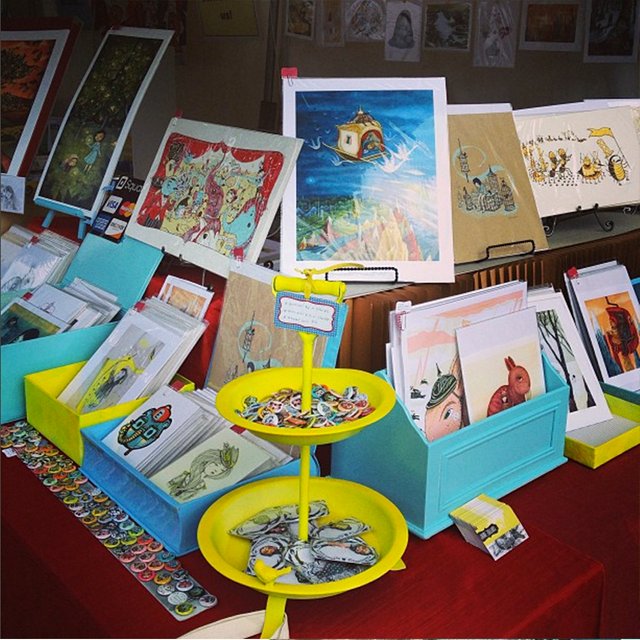 Photo of a section of my booth at Artscape in Baltimore a few years back.
Photo of a section of my booth at Artscape in Baltimore a few years back.
Part One: Finding Shows and Getting In (link to previous post)
Part Two: Preparing Your Work
Part Three: Preparing Your Display
Part Four: Getting Sales
Part Five: After the Show
Part Two: Preparing your work
Congratulations! You have made it into a show!
OR, you are reading this early in order to be properly prepared. Before even applying, it makes sense to read all of the posts in this series to understand what the art fair world is all about and whether or not it is for you.
Once you have made it into a show, you will have many things to do. Being prepared is important for a low-stress, higher-profit experience. I’m most familiar with the 2D art and printmaking categories at these events and will continue to focus on those here, but much of this information applies to other categories. Feel free to reply to this post with questions if I have forgotten something.
What will you sell?
Chances are you fall into one of two categories. You either produce original pieces or prints/multiples for sale. You may create a little of both.
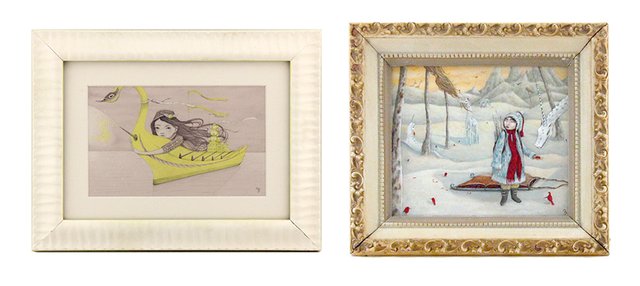 A couple of my original pieces
A couple of my original pieces
Fine Art Originals
If you create original fine art pieces, hopefully you have art pieces ready for sale and have scheduled in some time to create more.
Beyond having a solid collection of work to sell, the most important thing to consider is that your buyers will want to see variety within your brand. If you paint epic 4’ beach landscapes or abstract color works for large sitting rooms, you ought to consider creating smaller companions - little portraits of seashells to accompany your landscapes, or miniature modern color studies to sit next to your abstract works. The number one question I have been asked at events for the past 10 years is “What else do you have that will go with this piece?”. If a new fan discovers your work, they may want to complete an entire room with a series. And those who long for your most elaborate work -but don’t have the budget- may start their collection with a smaller, less expensive piece. Divide and display your work into series' so that you may sell multiples to the same buyer, or tempt fans to come back for others at a later time. For those who produce original artwork for sale, the ability to create work consistently (even when there is no pressing need) is essential to build enough work for the holiday season or multiple shows. Making a calendar and designating specific work hours for this task is important.
Prints and Products
I fall into this category. I’m WAY too slow of a painter to sell originals at shows, so I opted early on to resort to selling high quality archival digital prints, screen prints and illustrated products. The benefits of going this route are not having to create brand new work for every show, being able to offer your work at a more affordable price to more people, and getting to experiment with new uses for your imagery. Alas, this route also means you must sell more quantity than when peddling original wares, and often requires making an investment in equipment or investing in outsourcing products.
The following is a brief overview of the most common illustrated products and how to produce them:
Fine Art Prints
This is my big seller at art fairs. I print my own prints because the profit is much higher when printing your own. To do so, you must invest in a professional printer that will print with long-lasting ink on acid-free art paper. I print on an Epson SureColor P600 - which is a bit of an investment at $800, but I earned the money back quickly after its purchase. I expect this printer to last me about 5 years. My favorite kind of paper is Epson Velvet Fine Art Paper, but a good quality matte heavyweight paper will do the trick. When possible, printing in standard sizes for framing (5x7”, 8x10”, 11x14”, 16x20”) is a selling point for those who are in the know (having paid a premium for framing less common dimensions). If you opt to have someone else print your work there is no big upfront cost, but most professional places will cost $7 (minimum) per square foot, as opposed to about $1.50 or less if you already own a printer.
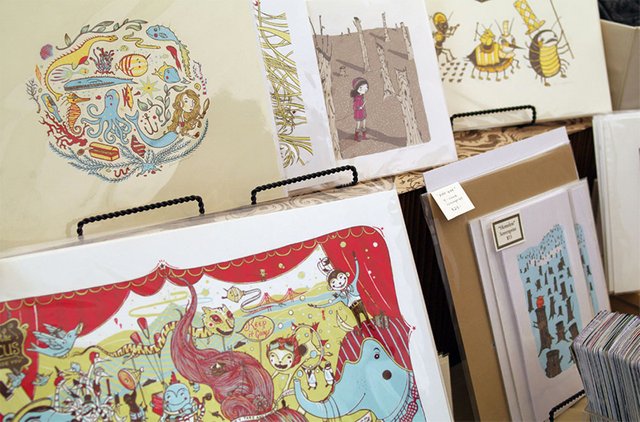
Once you have high-quality prints ready to go, you may want to consider ways to diversify your offerings. I commonly had people asking for very large versions of my work that I could not print myself. This led me to research outside sources to print posters of my work.
Posters
There are lots of online possibilities for ordering posters. Posters are of lesser quality than Fine Art Prints. You can buy them cheaply (VERY cheaply in large quantity) and can offer them to buyers at lower rates. I reserve poster-printing for those few popular images I know I can sell in large quantity. If you do many shows and are willing to invest, buying larger quantities of any printed products is almost always exponentially (comically) cheaper per copy. For instance, a typical price for 50 16x20” posters on heavyweight paper might be around $380. A typical price for 1000 16x20” poster is around $465. For less than $100, you can get 950 more posters. This is a consistent conundrum for printing across all products, and is the reason I have insane quantities of printed items in my house. There are many places to print posters online, but I have printed with U Printing on heavyweight stock over the years and have been quite happy with the results.
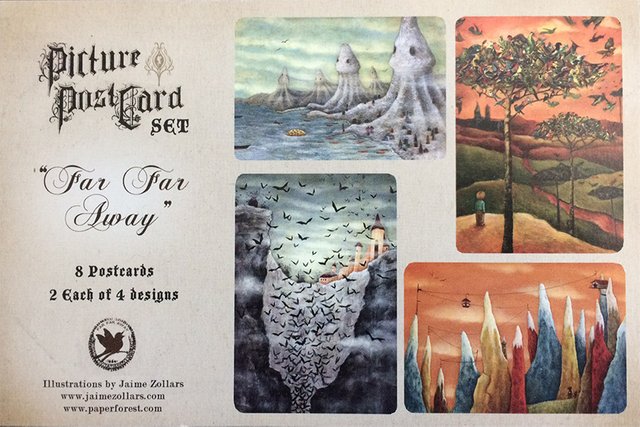
Postcards and Greeting Cards
To postcard or not to postcard, this is indeed a good question. When I started selling prints I decided that selling postcards would be a bad idea. There were always people at shows who would fall in love with a piece and ask if I had a smaller version or a postcard. When I didn’t, they would buy the print. I figured that selling postcards would stop folks from buying the actual thing. Over the years I’ve discovered that at shows with lots of casual buyers, having postcards to sell can really help my bottom line. I sell my postcards for $2 each or 3 for $5. There are lots of people out there who collect them, and others who will buy a set because they like your images but can’t afford large copies. Selling $2 items is very good for my business overall and adds up. At one large three-day event I once sold over $500 in postcards alone, covering my booth fees entirely. There are many places to order postcards online. I’ve been quite happy with the price and quality over the years at Overnight Prints. They print greeting cards as well.
Shirts / Clothing
If you have a graphic style to your work and you can imagine your designs on clothing, it can be lots of fun to see your work on wearables. It is much easier than you might think to make and sell t-shirts or similar items. There are companies who will do everything for you (just try a simple web search for custom t-shirts). If you are picky about the garments you want to print - it might make sense to find a printer who will do “contract printing”. This means that they will print on products that you provide, charging only a per-item printing charge per ink color. If you have a wholesale license (very easy to apply for this in most states online) you can buy shirts in quantity at wholesale prices from places like Alternative Apparel or Next Level for a higher-end look. When printing, do consider water-based printing for thinner fabrics. Printing water-based avoids the plastic feel of some printed t-shirts. If you want to print light designs on dark fabrics, see if your printer will do a discharge printing. This is a technique that bleaches out the design area before printing, allowing for a soft shirt, even when printing light colors on dark fabrics.
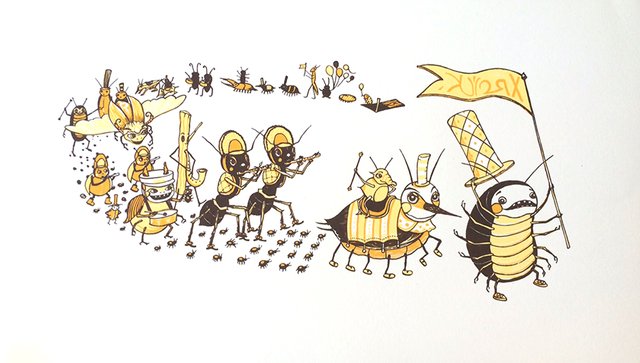
"Bug Parade", one of my 4-color screen printed posters
Screen-Printed Posters
Screen-printed posters are a perfect answer for those with bold art styles. Screen-printing on paper is just like screen-printing on t-shirts, using paper as the base. Printing this way means that the colors are separated out and printed individually, sometimes working with each other in the overlap to make additional color combinations. I used to print all of my own screen prints, but in recent years I’ve printed most of my screen-printed posters with VGKIDS.
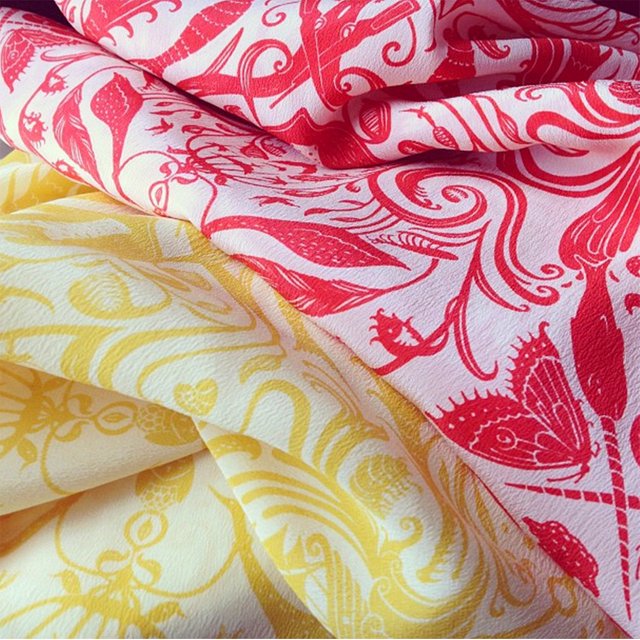
Textiles
If you like creating repeat patterns, you might want to try digitally printing on fabric. Spoonflower will let you print small quantities of your designs, so that you may use it to make your own items for sale, like pencil holders or tote bags. Another option is to have digitally printed fabric items made for you. I have had success printing scarves with DPI-SF. They have no minimum quantity - so it is a good place to get your feet wet and see how your work looks printed on fabric. They also create other items on this site. The per item cost is high if you want a large quantity, but competitive if you are ordering smaller quantities for high-end shows.
Pins / Jewelry / Buttons
I have had lots of fun seeing my work printed on plastic and wood and laser cut. I have had a very good experience with my order on wood at Ink It Labs.
Ponoko is another site where you can have items cut. They have an impressive menu of materials from which to choose.
Shapeways is a site where you can create custom items to be printed with 3D printers.
On both Ponoko and Shapeways you can offer your designs for sale on the site and they’ll print them to order!
Busy Beaver is a good source for buttons! There are lots of button sources online. Or you can buy your own button maker for a fun DIY approach!
Endless options
My list of potential items is just the beginning. In a world where digital printing is the norm, you can make quality items from your art for sale very easily. Just be sure to check the quality of items before ordering online. Most suppliers and printers will send you samples for free or for the cost of shipping if you are considering a purchase.
Packaging Your Work
Packaging your work well is important. If you are selling prints, I recommend backing them with cardboard and sealing them in clear bags. This is important to protect the work at and in-between shows. Clear Bags is a good source for packaging prints and cards and other items. Uline has almost anything you can think of in terms of packaging and mailing items. They have lots of boxes and gift bags and mailing tubes in quantity.
Containers and Packaging is an online shop for all kinds of containers.
Custom labels are a nice way to brand your work. Frontier Label and https://www.lightninglabels.com are good choices that both offer different shapes, sizes, and paper textures.
When packaging a print with backing board in a plastic bag, it is a good idea to seal in a business card. Not all of those who buy your work will remember to take one! It is also a good idea to have a logo that represents you on all of your promotional materials. We'll talk a bit more about this and the importance of branding in part three.
Thanks for reading Part Two: Preparing Your Work. If your missed Part One: Finding Shows and Getting In, you can read it here.
Now you should have a basic understanding of show applications and preparing your work to sell.
Next, you’ll need to start preparing your booth. In Part Three: Preparing your Display you will learn about the basics of an operational booth, as well as displaying your work to sell. Expect that post to surface soon.
If you have questions to ask or advice to add on this topic, please reply and comment!
Images © Jaime Zollars
Great advice! I adore "Bug Parade," it's really well done!
thanks! that is one of my favorites :)
Yes! I've been waiting for your follow up and it does not disappoint. Excellent post- resteemed!
hi @opheliafu! I could definitely see your work on products :)
Thank you for this, @storyseeker. You are a fountain of knowledge! :)
Thanks @fairytalelife ! Let me know if you ever try your hand at this sort of thing !
What a great post @storyseeker!
Thanks @macksby !
Wow this is incredible and really informative! Would you consider selling your prints and/or originals on Peerhub for Steem Dollars? I would love to buy one.
Yes, I was thinking of doing that, actually! I was on there the other day poking around and considered posting some things. I'll let you know when I do!
oh, and thanks for the nice words too!
Awesome! I can't wait, please let me know when you do :-)
Good one
thanks!
good information, excellent post :-)
Thank you!
Excellent post!
Great article!
A new but high quality option for your postcards is BusinessPrinting.com